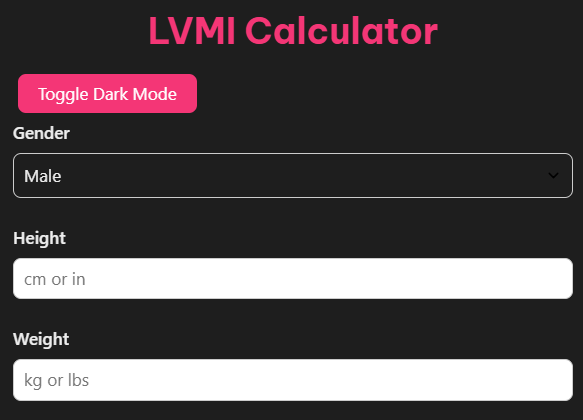LVMI Calculator
LVM: - g
BSA: - m²
LVMI: - g/m²
Interpretation: -
The heart, the body’s most vital organ, requires constant maintenance and monitoring to ensure it functions perfectly. One essential measure in cardiac health assessment is the Left Ventricular Mass Index (LVMI). LVMI helps healthcare professionals evaluate the health of the left ventricle, a key chamber in the heart responsible for pumping oxygenated blood to the body.
Anomalies in LVMI values can indicate conditions like left ventricular hypertrophy (LVH), which is closely associated with an increased risk of heart diseases. Whether you’re a healthcare provider or someone keen on managing your heart health, knowing your LVMI can empower you with crucial insights.
Understanding the LVMI Calculation
LVMI measures the left ventricular mass (LVM) relative to body surface area (BSA). The formula used is:
LVMI = LV mass / BSA
Where:
- LV mass is calculated using echocardiogram measurements of the left ventricle, such as:
- LVEDD (Left Ventricle End-Diastolic Dimension)
- IVSd (Interventricular Septal Thickness, measured at end-diastole)
- PWd (Posterior Wall Thickness at end-diastole).
- BSA (Body Surface Area) accounts for the patient’s height and weight.
The calculation integrates the following equation for LV mass:
LV Mass = 0.8 × [1.04 × ((LVEDD + IVSd + PWd)³ − LVEDD³)] + 0.6
Accurate LVMI values provide critical indicators for diagnosing cardiac abnormalities.
Normal LVMI Ranges
Gender-specific normal ranges help determine if LVMI is within healthy limits:
- For Women (g/m²):
- 43–95 (Normal)
- 96–108 (Mild increase)
- 109–121 (Moderate increase)
- ≥122 (Severe increase)
For Men (g/m²):
– 49–115 (Normal)
– 116–131 (Mild increase)
– 132–148 (Moderate increase)
– ≥149 (Severe increase)
### Classification of Abnormalities
LVMI results, combined with Relative Wall Thickness (RWT), classify heart changes as concentric hypertrophy, eccentric hypertrophy, or remodeling:
– Concentric Hypertrophy: RWT > 0.42 with increased LVMI.
– Eccentric Hypertrophy: RWT ≤ 0.42 with increased LVMI.
- – Concentric Remodeling: RWT > 0.42 with normal LVMI.
Revolutionizing Cardiac Health with Our LVMI Calculator 2025
The LVMI Calculator 2025 introduces cutting-edge technology to the world of cardiac health assessment. Designed for simplicity and precision, this calculator eliminates potential guesswork, ensuring accurate results every time.
Key Features of our LVMI Calculator
- User-Friendly Inputs: Provides fields for LVEDD, IVSd, PWd, height, and weight.
- Automatic BSA Calculation: Saves time by deriving BSA directly from height and weight inputs.
- Instant LVMI Calculation: Quickly processes the data to deliver precise values for immediate interpretation.
- Gender-Specific Interpretation: Clearly indicates whether results fall within normal or abnormal ranges.
- Classification Insights: Determines concentric or eccentric hypertrophy based on LVMI and RWT.
- Dual Unit Options: Allows switching between metric (cm, kg) and imperial (inches, lbs) units, ensuring accessibility worldwide.
- Visual Indicators: Color-coded ranges for normal, mild, moderate, and severe LVMI levels enhance user understanding.
- Medical Disclaimer: Ensures results are used as informational tools and not as replacements for professional diagnosis.
Using the LVMI Calculator

Follow this simple, step-by-step guide to assess LVMI effectively:
Step 1: Find required measures via an echocardiogram (LVEDD, IVSd, PWd).
Step 2: Input height and weight into the calculator to compute BSA automatically.
Step 3: Enter all other required measurements.
Step 4: Hit “Calculate” to receive your LVMI result instantly.
Step 5: Review the interpretation and color-coded indicators for abnormal values or heart enlargement classification.
What LVMI Results Mean for Your Heart
Interpreting LVMI results is crucial for understanding heart health. Abnormally high LVMI values can signify conditions like:
- Concentric Hypertrophy: Thickened walls due to increased pressure, common in hypertension.
- Eccentric Hypertrophy: Dilated ventricles from high volume load, often related to mitral regurgitation or aortic insufficiency.
Elevated LVMI indicates an association with cardiovascular risks, such as heart failure, myocardial infarction, and arrhythmias. Addressing these abnormalities early can significantly improve prognosis.
Why our LVMI Calculator makes a significant impact:
- Provides efficiency by reducing the manual workload for healthcare professionals.
- Minimizes human error risks, ensuring accurate analysis crucial for heart health.
- Offers instant results, empowering users to make informed decisions quickly.
Check Your Heart Health Now
Whether you’re a healthcare provider striving for precision or an individual managing personal heart health, our LVMI Calculator is the ultimate companion. Its usability, accuracy, and insights turn overwhelming cardiac assessments into a seamless process.
Don’t leave your heart health to guesswork. Take control today!
Check Your Heart Health Now.